BAY ISLANDS DIVING
With easy access to the world’s second largest barrier reef, the Bay Islands of Roatán, Utila, and Guanaja, not forgetting Barbareta and 60 or so other cays, are best known for diving. Nearly every hotel and resort offers some form of dive package. So what makes the Bay Islands such a famous place for scuba diving? It’s the variety of dive sites you can find just offshore of the three islands. On Roatán there are wrecks, like the intentionally sunk 100-meter (300ft) Odyssey, the reef sharks that get together in the deep waters at Cara a Cara Point and dramatic crevices like Mary’s Place where the sunlight can hit at just the right angle that it becomes illuminated. On Utila, Duppy Waters is home to huge barrel sponges, while whale sharks can be found on the north bank of the island.
Utila
Despite being the smallest of the Bay Islands, Utila ‚ [map] might be the most interesting. It’s not really a beach island, though there are a few sandy stretches. There are no large settlements other than East Harbour, where the ferries dock. Residents are mostly descendants of pirates and Garinagu from the Caymans, plus a mix of expats who came diving here and just never left. Much of the island is covered by mangroves and there are even tales that Captain Morgan buried treasure from a 1671 raid in Panama somewhere in the hills.
There are two beaches within walking distance from town, Bando Beach, which is privately owned and rents snorkel and kayak gear, and Chepes Beach near Sandy Bay. For a more paradisiacal experience, there’s Water Cay, essentially a sand bar with a few palm trees, ringed by turquoise water.
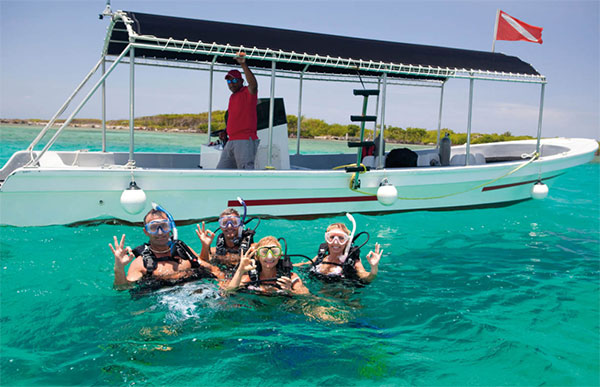
Divers off Roatán.
iStock
Diving here is spectacular and prices for dives and certification courses are lower than almost anywhere. Dive shops like Utila Dive Center (www.utiladivecenter.com) and the Bay Islands College of Diving (www.dive-utila.com), line the main drag in East Harbour and every hotel can help set you up with an all-inclusive rate. There are nearly 100 permanent mooring buoys that give access to various reefs and wrecks within a short boat ride of the shore. Whale sharks are commonly seen in March and April and most dive shops will run snorkeling trips.
Guanaja
On July 30, 1502, Christopher Columbus landed on Guanaja ⁄ [map] , 12km (7 miles) east of Roatán and the least developed of the Bay Islands. Like Utila, Guanaja was a pirate hideout and many of the residents descend from these buccaneers. In 1998, Hurricane Mitch winds blew over the main island’s pine trees and wiped away many of the stilted houses. Much of the main island remains untouched by development, apart from a few houses, hotels, and an airstrip; however, tiny Bonacca Cay just offshore is perhaps the most densely populated place in Honduras, where five thousand people crowd in a maze of pastel-colored houses, many of them hanging off the land on stilts. There are a few beaches on the main island, all of them quite empty and raw. Diving is good here and many boats come from Roatán on day trips.
La Mosquitia
The largest tract of virgin tropical rainforest in Central Americas remains almost entirely unexplored. Only recently have archeologists and explorers uncovered stone cities, revealing a lost civilization that remains a mystery. Covering the entire northeastern part of the country, La Mosquitia is sparsely populated, with the exception of a few small towns and isolated Pech, Tawahka, Garífuna, and Miskitos villages. The region is only loosely controlled by the government and drug traffickers have taken advantage, disrupting what was beginning to look like a blossoming ecotourism industry.
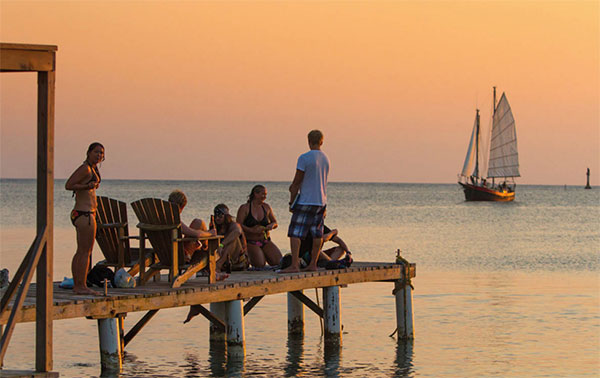
Enjoying the sunset from a waterfront dock in Útila.
Getty Images
Río Plátano Biosphere Reserve
Named a Unesco World Heritage Site in 1980, the 525,000 hectares (1.3 million acres) Río Plátano Biosphere Reserve ¤ [map] is home to a diverse set of rare ecosystems including wetlands, pine savannas, and tropical forest. The only inhabitants are a few Pech and Miskito communities who live in much the same way as they have for hundreds of years. The array of flora and fauna is dazzling, with bucket list species after bucket list species: jaguars, harpy eagles, Baird’s tapirs, and many others.
Despite its natural wonders, most of the park is almost inaccessible. For much of the rainy season, travel here is impossible, while during the dry seasons, running from February to May and August to November, it requires a series of air, boat, and overland connections to get into the interior, which begins to pile on costs, especially for solo travelers. The easiest way is to fly to airstrips in the northern end of the park, such as Raista or Brus Laguna, where there’s lodging and tours can be arranged deeper into the reserve. One option is the 10- to 14-day rafting trip down the Río Plátano, which are run once or twice a year by tour operators in La Ceiba.
Laguna de Ibans
The large lagoon of Laguna de Ibans ‹ [map] , separated by a narrow sandbar from the Caribbean, has been to focus of numerous tourism projects in recent years. Along its shores are several Miskito and Garífuna villages that have launched conservation initiatives. In Plapaya, the Sea Turtle Conservation Project helps protect the green, loggerhead and leatherback turtles that nest on nearby beaches from February to September. In the adjoining Miskito towns of Raista and Belén, which share an airstrip utilized by charter flights organized by tour agencies in La Ceiba, there are a few small ecolodges and a good beach. Community run tours explore the Parú, Ilbila, and Banaka creeks to spot monkeys and caimans.
Las Marías
Inland from Raista and Belén, Las Marías is as far upriver as you can get by motorized boat. The traditional Pech community on the Río Plátano is the base for many travelers coming to the reserve. With the help of NGOs the village has trained dozens of guides and naturalists to lead various guided hikes, like the three-day round trip ascent to the top of Pico Dama, and canoe trips to the Walpaulban Sirpi petroglyphs. Additionally, they’ve built a few surprisingly comfortable guest rooms for those who come. All profits are split among the community. Upon arrival tourists are introduced to the sacaguia, a head guide elected for a six-month period, who coordinates all tours and rooms.
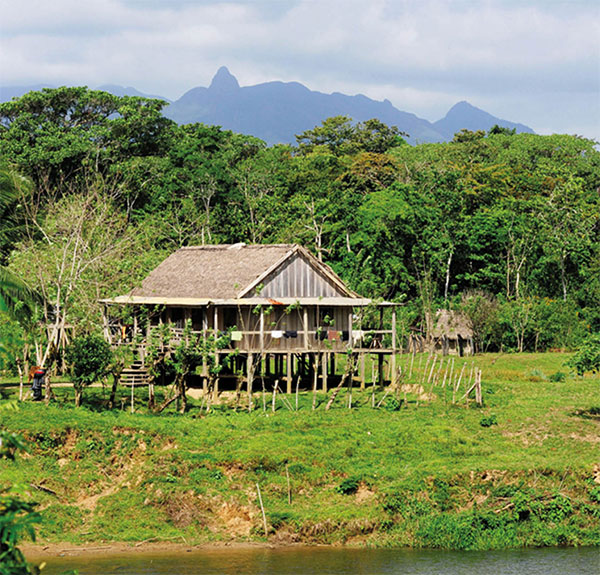
Traditional house in Las Marías.
Alamy
INSIGHT: WEIRD AND WONDERFUL WILDLIFE
Central America harbors magnificent natural treasures – hundreds of species of birds, mammals, and colorful marine life, forming a paradise for the wildlife enthusiast.
Visitors to Central America often spend their time clambering over its awe-inspiring Maya ruins, sunning themselves on its gorgeous beaches, or exploring old colonial towns, but many birders, divers, and wildlife enthusiasts flock here above all for its uniquely rich and diverse natural environment.
A biodiversity hotspot with migrations running in both directions, the sheer array of different species found within the region is astounding. There are seven species of monkeys found in Central America, which includes Geoffroy’s spider monkey, found in every country in the region, as well as the mantled howler and the white-headed capuchin, not to mention sub-species like the Coiba Island howler. There are healthy jaguar populations, as well as ocelots and other big cats, in undeveloped regions like La Mosquitia and the Darién Gap, while other mammals like tapirs, sloths, anteaters, capybaras, and pacas can also be seen. Reptiles like poison dart frogs and coral snakes often stand out for their bright colors.
The Caribbean coast is one of the richest regions on earth in coral formations. Reefs, in turn, harbor an incredible variety and density of marine life. Over 50 species of coral, 400 of fish, and 30 gorgonians have been identified along Central America’s reefs, along with hundreds of mollusks, crustaceans, sponges, and algae. Both coasts are major nesting sites for five species of sea turtles, including leatherback, Olive Ridley, and hawksbill.
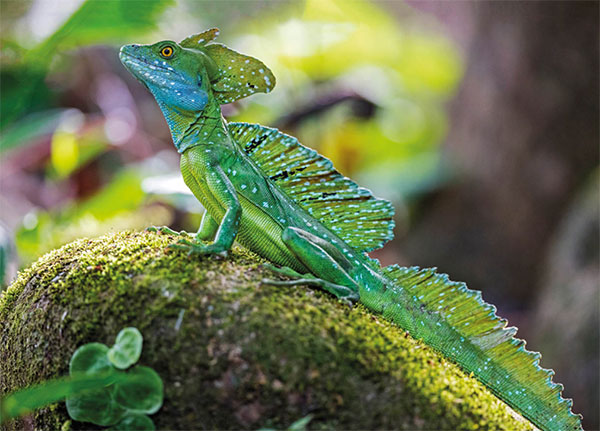
An emerald basilisk lizard found in Sarapuiqi, Heredia Province, Costa Rica.
Getty Images
Habitat threats
Despite the efforts to protect Central American forests, habitat destruction has had a serious effect on some of the birds. The quetzal is particularly vulnerable because it largely depends for survival on one special aguacatillo tree, found only in the cloud forest. The three-wattled bellbird shares this habitat, and is equally threatened when forests are converted to pasture. Great green macaws are the most threatened species of macaw. Conservation efforts on the Caribbean coast, where they exclusively live, include honoring farmers who maintain the dipteryx trees upon which the macaws feed. There are only 30 active nests recorded in the protected breeding area straddling Costa Rica and Nicaragua.
Even higher on the critical list is the region’s biggest raptor, the American harpy eagle. This giant monkey-eating bird is known to breed in the forests of the Osa Peninsula and Darién Gap, but sightings of it have become extremely rare. A handful of species, such as the cattle egret and roadside hawk, have actually benefited from man-made changes to the environment, because they need open ground on which to feed.
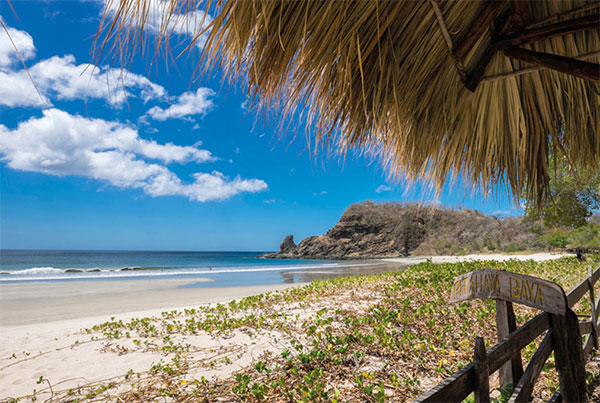
The resort of San Juan del Sur on the Pacific coast of Nicaragua.
Getty Images